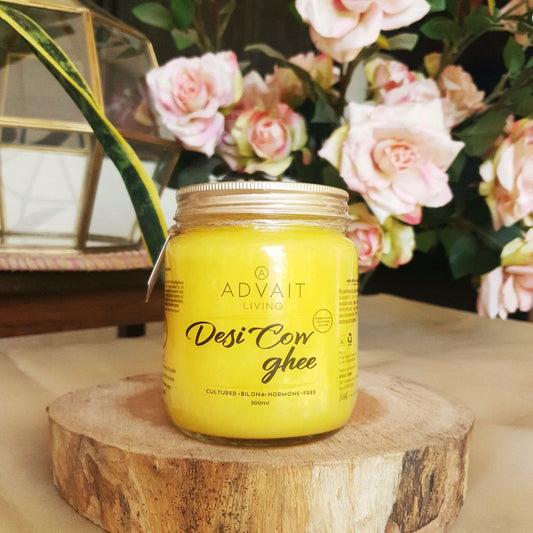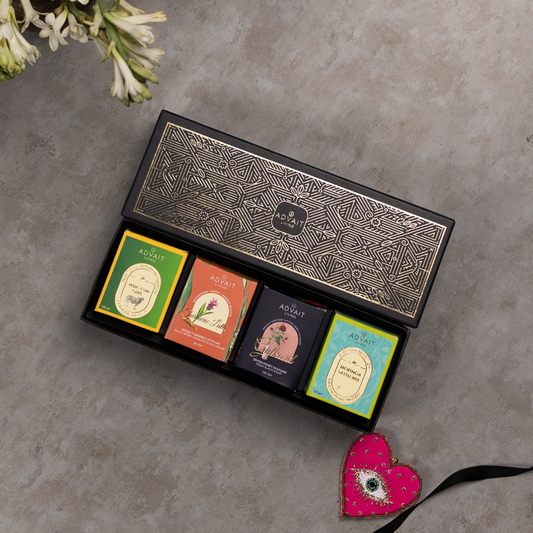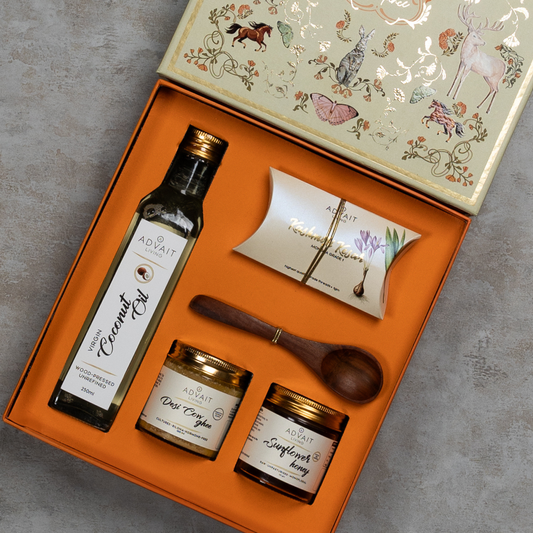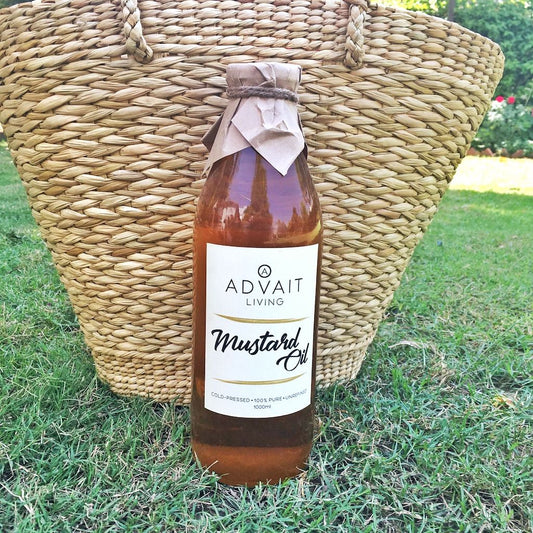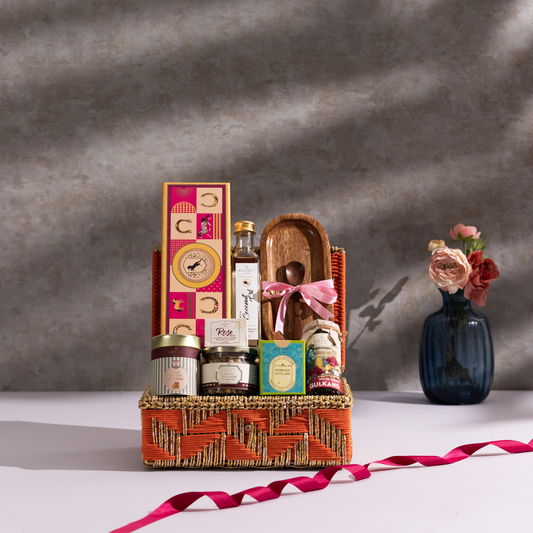It's widely acknowledged that two of the most vulnerable food products to contamination in India are milk and ghee. Yet, to enjoy its culinary uses and even take advantage of the several health benefits, ghee must be pure. If the desi ghee is compromised or its nutrients diminished, there is a strong likelihood that it may harm you rather than nourish you. To acquire genuine, untainted, and nutrient-rich ghee, sourcing it from a trustworthy provider is essential. Additionally, there are practical techniques and insights you can utilize to gauge the quality of your ghee.
Here are our recommendations when you set out to buy ghee from the market.
Understanding Adulterated Ghee
To begin, let's grasp the potential adulterants found in ghee. Adulteration can infiltrate various stages of the ghee production process, ranging from simple water dilution to more perilous additives like starch, urea, hydrogen peroxide (to make it last longer), artificial components, and even synthetic ghee.
The most prevalent form of adulteration occurs during milk collection at the farms. Farmers or milk collectors often add water to increase milk volume. However, in recent times, more serious and harmful substances have become rampant, and many of these adulterants remain undetectable. What's particularly misleading is that such adulterated milk or ghee manages to preserve an authentic appearance and flavour.
One of the most common ‘ghee-like’ products is the ‘vanaspati ghee’. Vanaspati ghee is a hydrogenated oil and not a ghee! It is made of vegetable oil (such as palm oil) that has been hydrogenated and hardened, making it a cheaper substitute for authentic ghee. The process of hydrogenation, which is conducted at low to medium pressure using a nickel catalyst, creates a hardened oil that looks and behaves similarly to ghee. However, this faux-ghee has harmful trans-fat that can directly impact one’s health negatively.
The other common adulteration process is when nefarious miscreants tamper with packaged ghee (of reputable brands) and inject water, urea, and even synthetic ghee and sell it as original ghee. But the most dangerous is when manufacturers use chemicals, compounds, emulsifiers and thickeners to create the optimum milk consistency and thickness and add colourants, synthetic flavourings and powdered substitutes to replicate the natural hue and flavour of the ghee. Many of these chemicals and compounds are hazardous to health and have been reported to cause serious conditions such as nausea, digestive disorders, and even cancer and can lead to death.
Selecting High-Quality Ghee in India
The most straightforward method to guarantee ghee quality is to craft it yourself at home. However, for those constrained by time, several strategies can ensure the purity and safety of store-bought ghee.
I. Milk Source
In India, ghee is produced from milk collected from various regions and sources. The prevalent practice involves utilizing 'mixed milk' from diverse animals such as buffalo, cow, goat, camel, and others. Segregating different types of animal milk is rare; typically, various milk varieties are combined for ghee production.
Nevertheless, recent market entrants specialize in ghee made from a single animal's milk, such as cow ghee, buffalo ghee, and goat ghee. When in search of ghee, trace the milk's origin and choose the variety that aligns with your preferences, culinary requirements, and budget. Desi cow ghee is prized for its delicate flavour and digestibility, while buffalo ghee is often favoured for its affordability, robust taste, and wide availability.
II. Hormonal and Antibiotic Injections
Hormonal injections, such as oxytocin or pitocin injections, are commonly used in the dairy industry to boost milk production in cows and other livestock. These injections contain certain hormones that mimic the effects of natural hormones involved in milk production. Antibiotics are a common drug used to treat cattle in India. Residues of synthetic hormones and antibiotics find their way into the milk of the treated cows, and when consumed by humans, such residues could potentially disrupt normal hormonal balance and may even be linked to early puberty in children.
Avoid ghee made from milk that is compromised and pumped with disruptors that can cause metabolic disorders.
III. Process of Making Ghee
There are several methods for preparing ghee, and each method impacts the quality of ghee differently, from its flavour, aroma, and colour to even its nutritional composition. The best quality of ghee is prepared using the traditional Ayurvedic bilona method. But this process requires large amounts of milk and renders the ghee expensive. On the other hand, cheaper quality ghee is produced commercially using the cream method to reduce cost and increase affordability.
Check how your ghee was made:
a) Traditional Ayurvedic bilona authentic ghee
b) Commercial cream-based ghee
In India, the traditional Ayurvedic bilona method has been used for centuries to produce ghee both in the villages and at home. Raw cow milk is boiled and converted to curd (fermented) before using a bilona churner to separate the butter. This butter is simmered slowly in clay pots and on medium heat to produce high-quality ghee with natural flavours, texture and aromas. The presence of medium-sized granules (danedaar ghee) is an indication of its distinct quality. The traditional process emphasizes manual labour, natural fermentation and involves slow simmering over low heat, resulting in a more pronounced and flavorful ghee with higher nutritional value.
IV. The Colour of Ghee Can Speak Volumes
Ghee colour arises from a combination of factors, primarily tied to the milk's origin, livestock diet, and seasonal variations.
Ghee produced from A2 cow's milk ranges from light yellow to a vibrant golden hue. The presence of beta-carotene in the cow's diet imparts this colour, reflecting its natural and unadulterated state. In contrast, buffalo ghee is pale yellow or even white due to differences in fat composition (compared to cow’s milk) and the buffalo's diet. Vanaspati ghee, on the other hand, is artificially processed and lacks the inherent hues of dairy-produced ghee. It is usually pale white in colour and remains so throughout the year.
The colour of traditionally produced ghee, also tends to change with seasonal fluctuations and the livestock’s diet throughout the year. For example, Cow ghee is bright yellow during summer and may become pale yellow in winter. This is due to seasonal fluctuations and the change of diet during summer, monsoon and winter. Changing seasons and vegetation impact the nutritional composition as well as naturally occurring carotenoids (the pigment that gives the yellow colour in ghee) that are transferred to the milk's fat content. These natural changes are indicators of the ghee's authenticity and can even offer insights into the livestock's well-being and diet quality.
On the other hand, commercially produced ghee will have a standard colour regardless of fluctuating seasons of livestock diets, indicating the use of artificial colours or chemicals to mimic the natural shades of traditional ghee.
V. Ghee Forms in Layers
Layers in ghee are a natural outcome and not a cause for concern. The presence of layers in your ghee is a result of the process involved in making ghee and the properties of its components. Typically, ghee separates into three layers: a solid layer at the bottom, a semi-solid layer in the middle, and a more liquid layer on top. This is because ghee is 99% saturated fats and fatty acids, and the layers indicate the separation of different fats.
With temperature changes, different saturated fats and fatty acids solidify or melt at different temperatures, resulting in the formation of distinct layers in the ghee. Traditionally produced ghee may have more noticeable layers due to the slower cooling process involved in making ghee, while mass-produced ghee might yield fewer or less distinct layers as it uses rapid cooling processes to make ghee.
High-quality ghee will remain soft and easy to scoop out of a jar, even when solid. In contrast, adulterated or hydrogenated ghee tends to remain solid consistently across temperatures throughout its shelf life.
VI. Granular or Danedaar Ghee
The granules are a result of the ghee-making process and the way the ghee is cooled and solidified. During the cooling process, especially if it's done slowly, the medium-sized grains or granules begin to form. These granules are essentially small, solidified clusters of ghee. As the ghee continues to cool, these granules solidify, giving the ghee a slightly grainy texture. This granular texture is considered a sign of high-quality ghee.
VII. Aroma and Flavour
Typically, a good quality ghee has a distinct and pleasing aroma that will permeate the kitchen and will be inherently comforting. It will also add additional flavour to your cooking. However, adulterated ghee may smell or taste foul when heated or used while preparing dishes. It is best to avoid any ghee that does not smell good or is rancid.
VIII. Good Quality Packaging
The safest choice for packing and storing the ghee is glass. Unlike plastic containers, glass packaging doesn't leach into the contents it holds, preserving the ghee for a long time. Glass bottles are unique as they also prevent the ghee from becoming rancid. The best quality ghee will come in glass containers. Larger packs may come in food-grade tins or even plastic containers. It is advisable to transfer such ghee into reusable glass containers for better storage and safekeeping.
Conclusion
In summary, if you are looking to buy a good-quality ghee, we recommend you consider selecting a handcrafted traditional bilona ghee. Not only does traditional ghee have better aroma and flavours, but it also has higher potential health benefits. In contrast, mass-produced cream ghee, while more readily available, may lack the depth of flavour and nutritional value.
Remember, when selecting ghee, it's essential to consider its source. Buy from trusted manufacturers who are transparent about their ghee-making process. Purchasing directly from manufacturers also removes mediators, thereby reducing the likelihood of adulteration in the supply chain.
At Advait Living Farms, we only prepare dahi-ghee that is traditionally made using the Ayurvedic bilona method to meet the highest purity standards. Our commitment to providing nutritional whole foods and helping you achieve your dietary and health goals sets us apart from other manufacturers. Know more about our dairy-rearing practices along with ghee-making techniques.
Frequently Asked Questions
Q. How do I choose the best ghee?
A. To choose the best ghee, it is recommended to select a product made using the traditional Ayurvedic bilona method, which preserves natural flavours, textures, and aromas. Prioritize ghee packed in glass containers to maintain its quality and freshness. Try our A2 Desi Ghee and experience the difference!
Q. How can I tell if the ghee I'm buying is pure and not adulterated?
A. The best way to ensure pure ghee is to buy from a trusted source. Check the details of the source, their dairy-rearing practices, their ghee-making process, and check adherence to quality. A good manufacturer will always share all details in great transparency. Quality and lab-test certificates are additional ways to check the purity of ghee.
Q. How do I know if my ghee is A2?
A. To determine if your ghee is A2, check with the manufacturer for an ‘A2-milk’ certificate. Ghee made with certified A2 milk is authentic A2 ghee. Refer to Advait Living’s A2 certificate for a better understanding.
Q. What are the key characteristics of pure Desi Ghee?
A. Identifying pure desi ghee involves looking for characteristics such as a pleasant aroma, a bright golden to pale yellow colour depending on the milk source, and a grainy texture, which is a sign of high quality. A good quality desi cow ghee will also tend to separate into layers with temperature changes. The layering of ghee is a natural occurrence due to the separation of different fats at varying temperatures. Be cautious of ghee that smells rancid or has an unnatural colour, as it might be adulterated.
Q. What is the perfect colour of ghee?
A. The perfect colour of a good quality desi ghee will always vary with seasonal fluctuations and livestock diet. This means the colour of ghee will change in summer, monsoon and winter! Ghee made from A2 cow's milk can be a light yellow to a vibrant golden hue, while buffalo ghee may be pale yellow or white during the year. The colour can be a good indicator of the ghee's authenticity and the well-being and diet quality of the livestock. On the other hand, vanaspati ghee (faux ghee) tends to have a pale whitish colour and will remain standard throughout the year, indicating the presence of additives to make it shelf-stable.
Q. Does pure ghee expire?
A. Yes, while pure ghee has a longer shelf life compared to many other fats due to its low moisture content, it can eventually go bad. Over time, ghee can become rancid, especially if exposed to contaminants, heat, light, or air. Pure and traditionally made ghee will usually last 6-9 months. To ensure the longevity of your ghee, store it in glass jars in a cool, dark place, preferably in an airtight container.
Q. Which is the best quality desi ghee?
A. The best quality Desi ghee is traditionally made using the Ayurvedic bilona method, as it retains a superior aroma, flavour, and higher nutritional value compared to mass-produced cream ghee. This type of ghee is crafted through a labour-intensive process that emphasizes natural fermentation and slow simmering, resulting in a product with higher potential health benefits.








